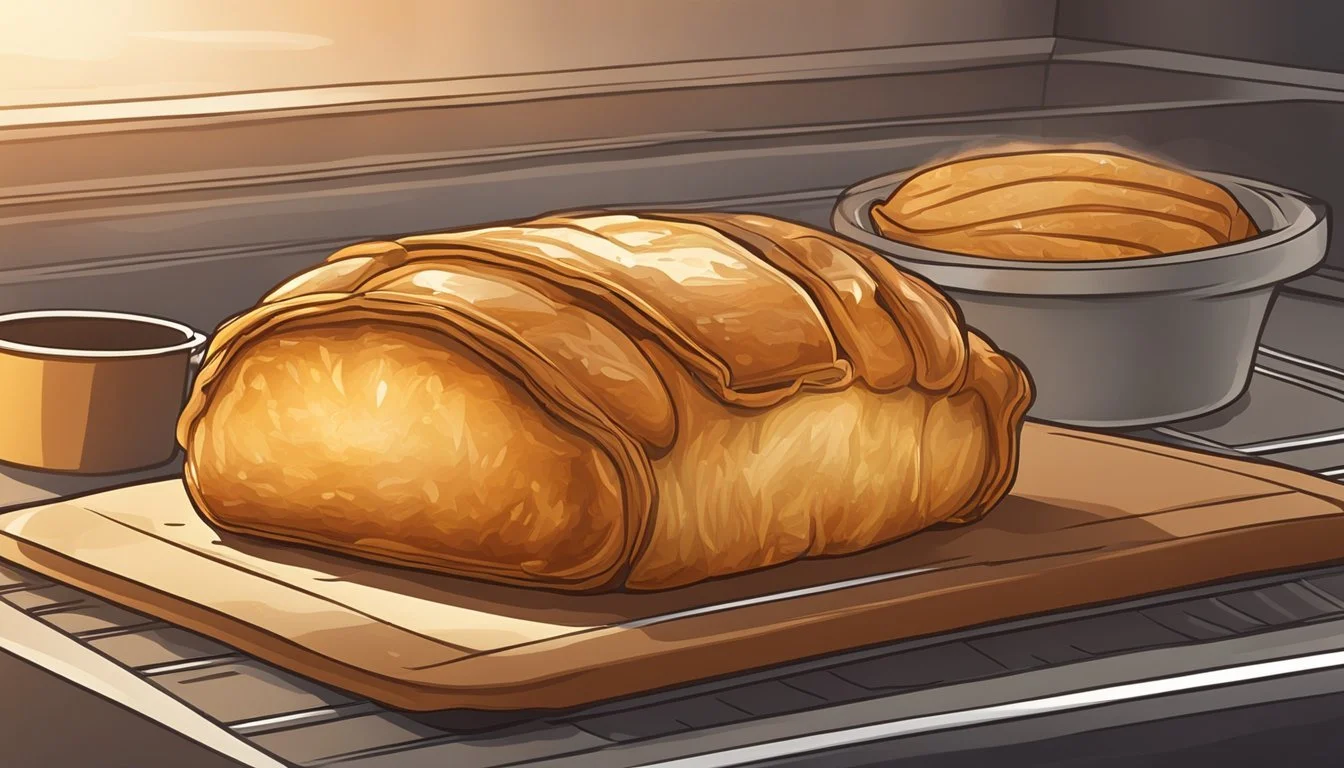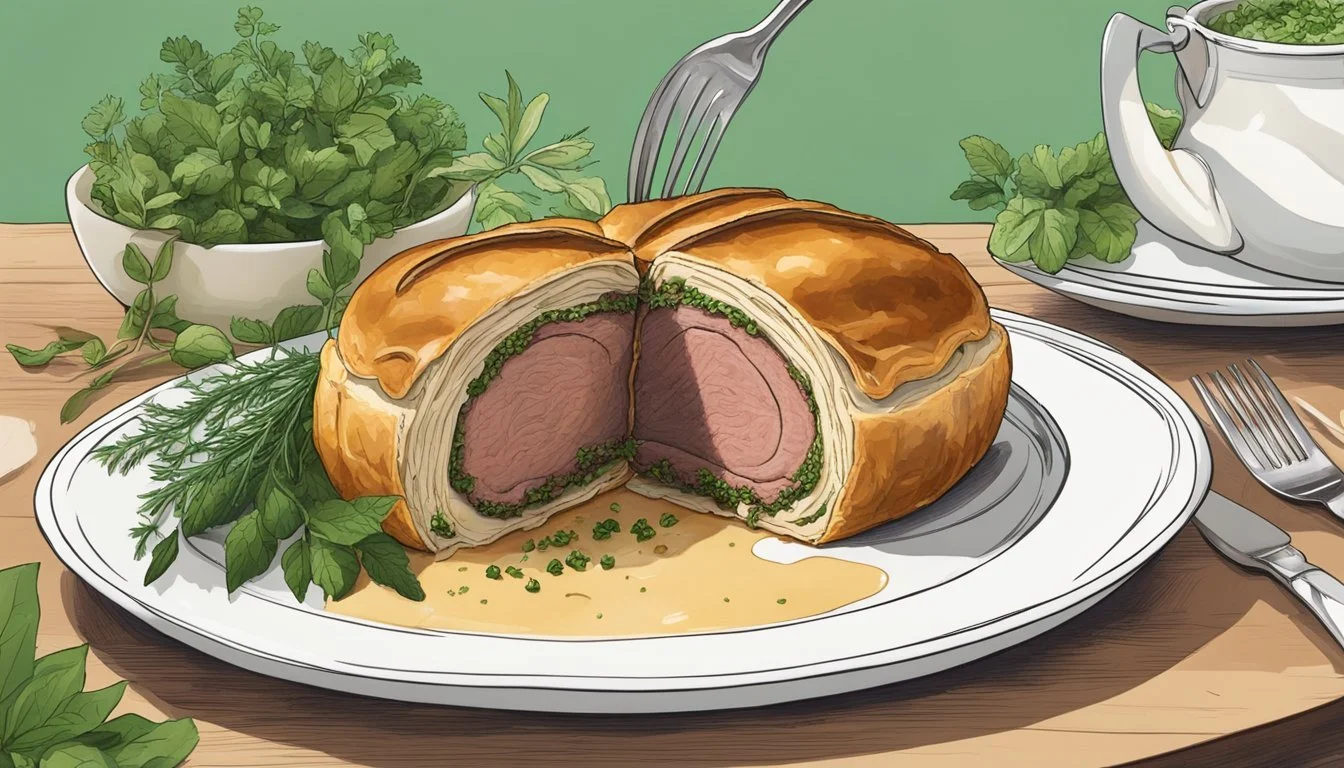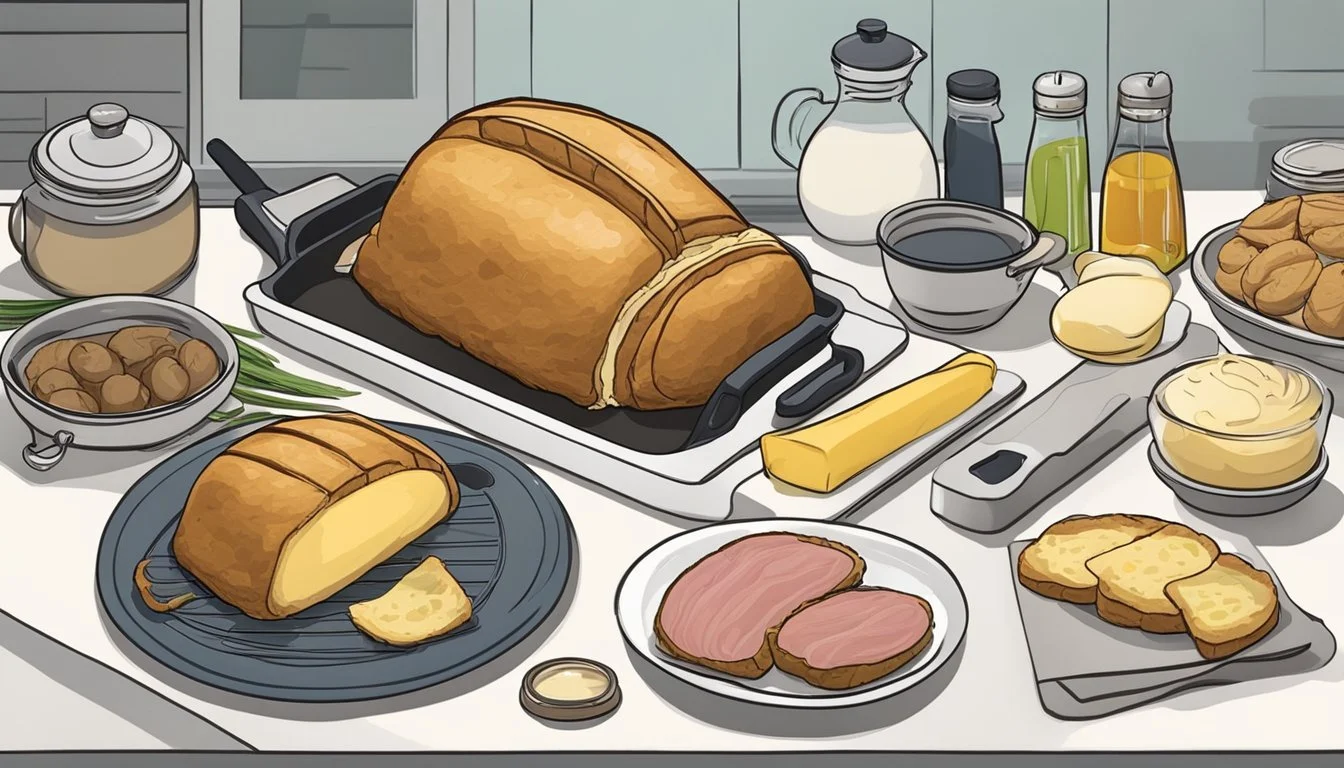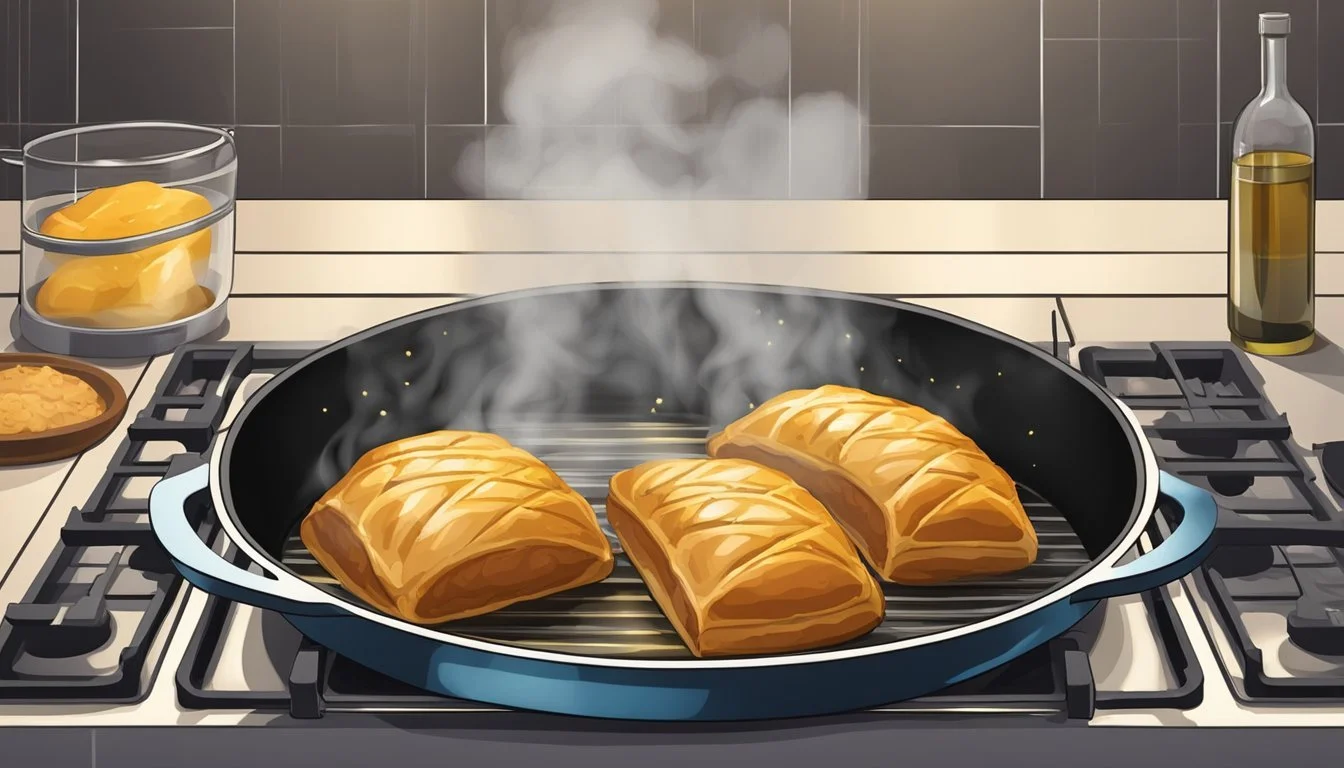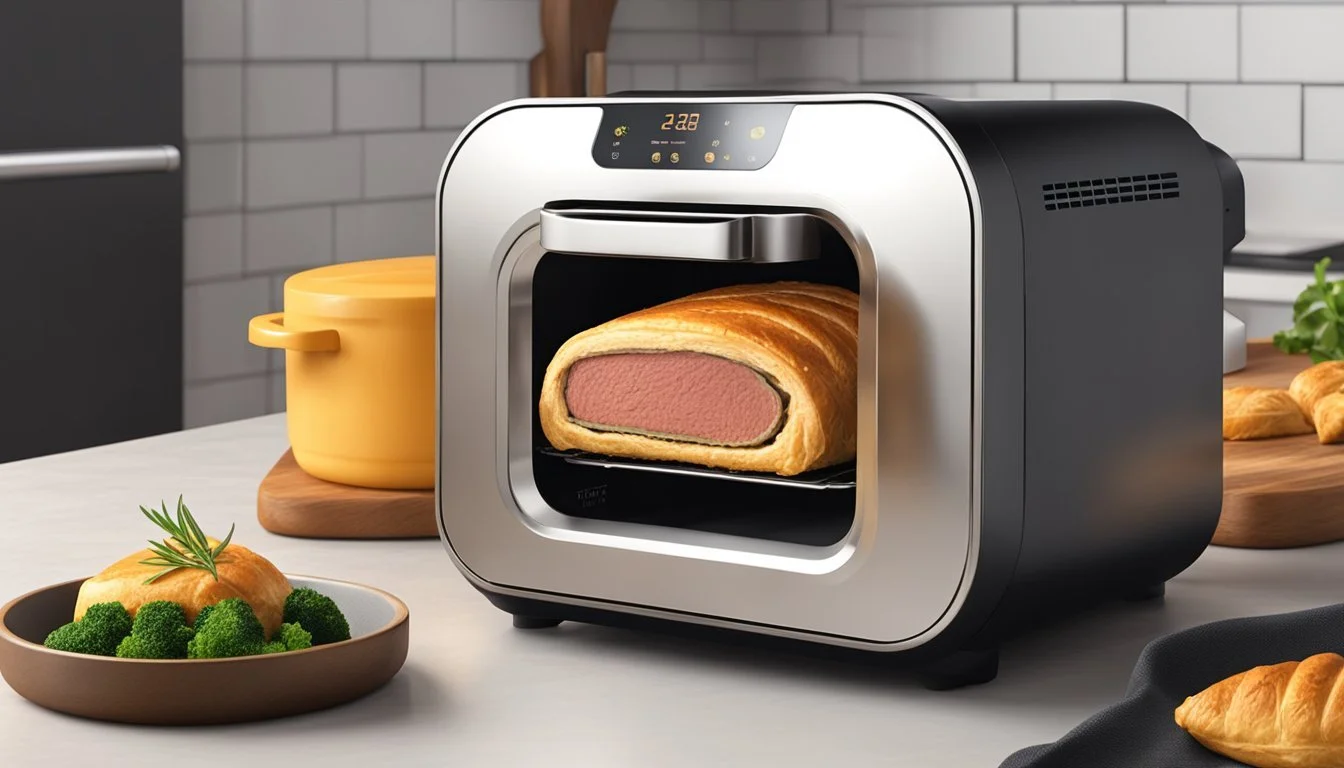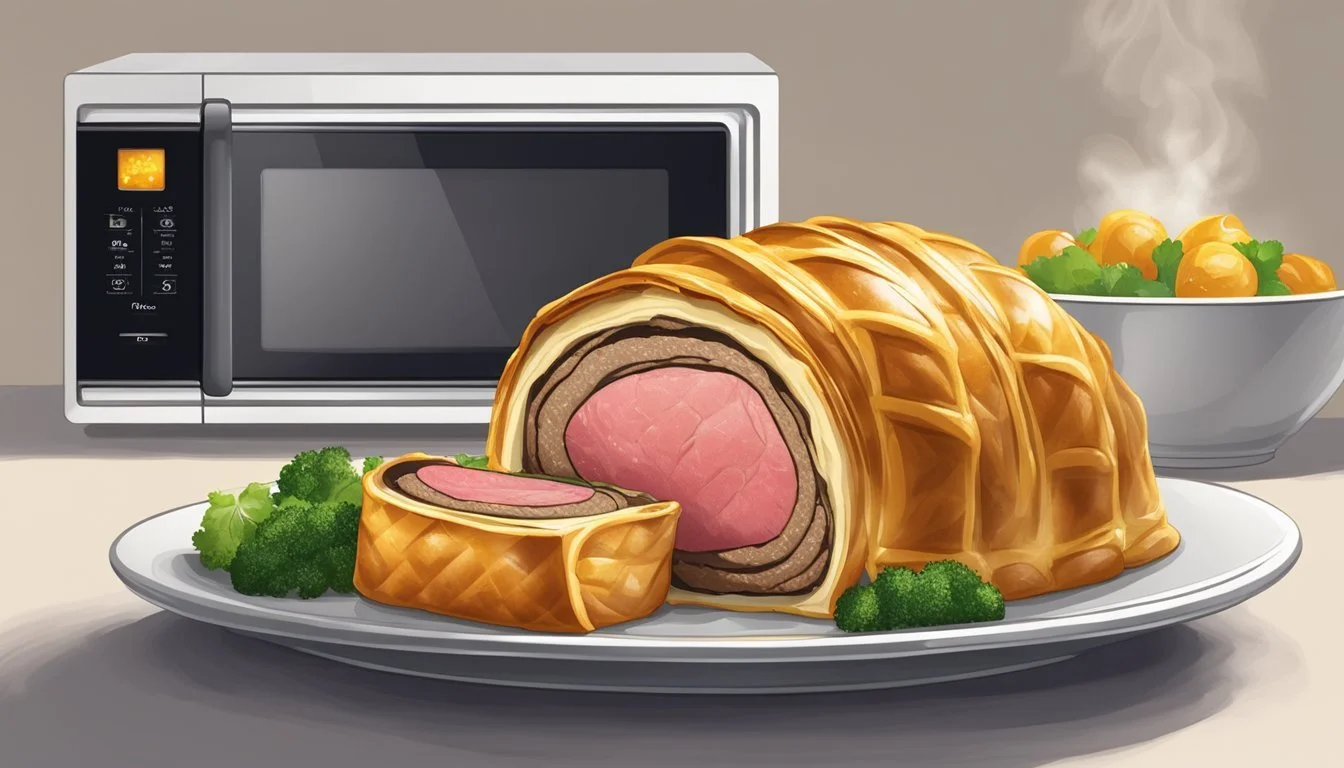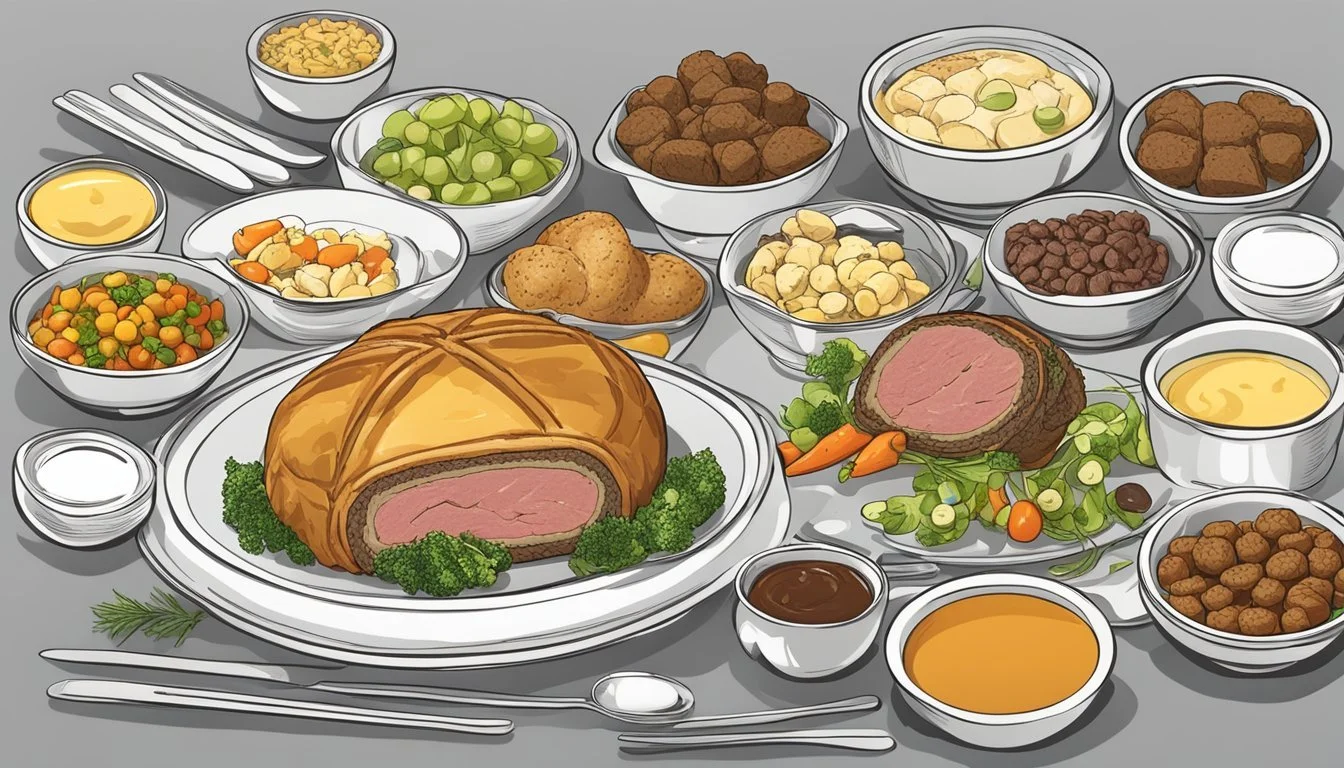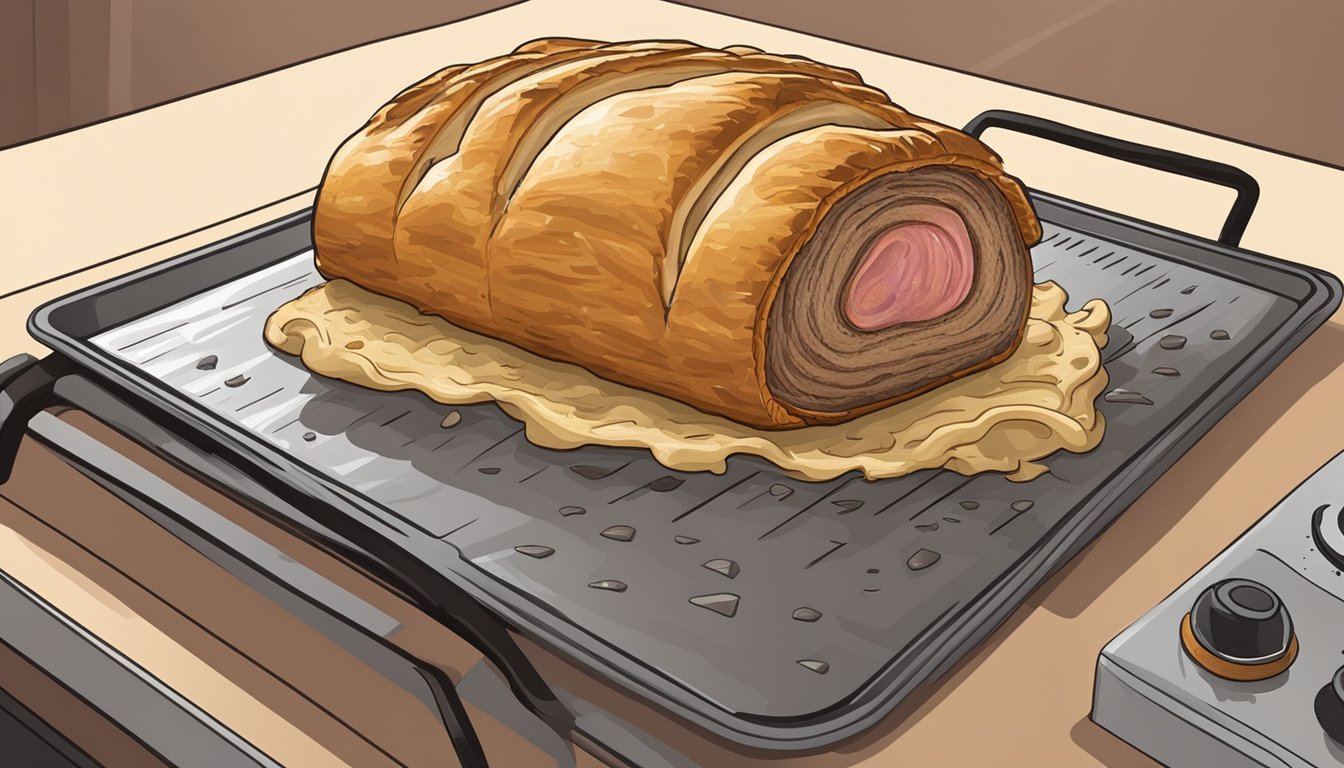How to Reheat Beef Wellington
Tips for Perfect Results
Reheating Beef Wellington can be a challenge, but when done correctly, it allows you to enjoy this luxurious dish as if it were freshly made. The key to reheating Beef Wellington is preserving its delicate balance of crispy puff pastry and tender, juicy meat. Whether you have an air fryer, oven, or stovetop at your disposal, there are several effective methods to choose from.
For those with limited time, an air fryer offers a convenient option by reheating slices at 250°F for about 10 minutes. This method ensures the meat is warmed through while keeping the pastry crisp. If you have more time, using an oven set at 250°F allows for gentle reheating, helping to maintain the quality of the dish without overcooking.
Those preferring stovetop methods can heat Beef Wellington in a skillet over medium heat with a small amount of oil or butter. Each approach has its merits, and the choice ultimately depends on available equipment and personal preference.
Understanding Beef Wellington
Beef Wellington is a classic English dish that combines a tender cut of beef with a rich array of complementary ingredients. This section will delve into the fundamental components and the necessity of preserving its flavor and texture.
Components of Beef Wellington
Beef Wellington features a center cut of beef, typically a beef tenderloin or filet mignon. This cut is known for its tenderness and subtle flavor. Surrounding the beef is a layer of duxelles, a finely chopped mixture of mushrooms and shallots, often combined with herbs and sometimes pate to enrich the flavor profile.
Wrapped around the duxelles is prosciutto, adding a salty and savory layer that complements the beef. The entire assembly is encased in a puff pastry, which becomes golden and flaky when baked. This outermost layer not only adds texture but also helps in retaining the moisture of the inner components during cooking.
Importance of Preservation for Flavor and Texture
Maintaining the flavor and texture of Beef Wellington is crucial during both cooking and reheating. The puff pastry must remain flaky and not become soggy, while the beef should retain its tenderness without overcooking. Incorrect reheating methods can lead to a dry or rubbery texture, diminishing the dining experience.
Optimal preservation includes careful monitoring of internal temperatures and using suitable reheating techniques. For instance, wrapping in aluminum foil while reheating in an oven can help maintain moisture. Balancing heat settings and cooking times is essential to ensure that each component, from the duxelles to the prosciutto, retains its original intent and flavor.
Pre-Reheating Preparations
Before reheating Beef Wellington, it is essential to properly prepare it to ensure the best possible texture and taste. Key considerations include thawing the beef wellington if it’s frozen and checking its quality.
Thawing Leftover Beef Wellington
For frozen Beef Wellington, begin by transferring it from the freezer to the refrigerator.
Allow it to thaw slowly in the refrigerator. This process typically takes around 24 hours.
Thawing slowly helps maintain the beef’s texture and prevents moisture loss.
Avoid using a microwave for thawing, as this can lead to uneven heating and affect the dish's quality. Once thawed, the Beef Wellington can then be prepped for reheating using one of the recommended methods.
Checking for Quality
Before reheating, inspect the Beef Wellington for any signs of freezer burn or spoilage.
Freezer burn appears as dry, pale, and sometimes discolored spots on the beef. If detected, trim away these areas before reheating.
Look for any off smells or unusual textures which might indicate spoilage. If the beef appears slimy or emits a sour odor, it should be discarded.
Storing Beef Wellington in an airtight container before freezing can minimize the risk of freezer burn and maintain its quality. Checking the beef's condition ensures that only the best pieces are served, resulting in a more enjoyable meal.
Reheating in the Oven
Reheating Beef Wellington in the oven ensures that the pastry remains flaky and the beef stays tender. Key considerations include proper preheating, moisture management, and monitoring internal temperature.
Preheating the Oven
Preheat the oven based on the condition of the Beef Wellington. If frozen, set the oven to 400°F (204°C).
For refrigerated or room-temperature Wellington, preheat to 250°F (121°C). This ensures a gentle and even reheating, maintaining the integrity of both the beef and the pastry.
Preventing Sogginess
To prevent the pastry from becoming soggy, ensure that excess moisture is minimized. Place the Beef Wellington on a wire rack over a baking sheet.
This allows air circulation under the Wellington, reducing moisture collection at the bottom. Consider adding a layer of parchment paper to the baking sheet for easy cleanup.
Using Foil and Parchment Paper
Cover the entire dish loosely with foil to retain moisture, preventing the beef from drying out. Avoid sealing the edges tightly, as this can trap excess moisture and make the pastry soggy.
If desired, place parchment paper under the Wellington to help manage any leaks and maintain a clean surface.
Temperature and Timing
Monitor the internal temperature using a meat thermometer. Insert the probe into the center of the Beef Wellington. Aim for an internal temperature of 130°F (54°C) for medium-rare.
For a frozen Wellington, start at 400°F (204°C) for 15 minutes, then reduce to 250°F (121°C) and continue until it reaches the desired temperature. For a non-frozen Wellington, reheating at 250°F (121°C) until it reaches the correct temperature is sufficient. Reaching a safe internal temperature ensures the beef is heated thoroughly.
By following these steps, the Beef Wellington retains its delicate balance of textures and flavors.
Reheating on the Stove
Reheating Beef Wellington on the stove allows for better control over the heating process and helps maintain the quality of the crust and the meat. Key points include the use of a skillet and protecting the delicate crust from becoming soggy or overcooked.
Using a Skillet
Place a non-stick skillet on the stovetop over medium heat. Add a small amount of butter or oil and let it melt and heat until sizzling. The sizzling butter ensures an even and gentle reheating process.
Slice the Beef Wellington before placing it in the skillet; this ensures uniform reheating. Cook each side for approximately two minutes. Use a meat thermometer to check that the internal temperature reaches at least 75°C (165°F) to ensure it is safe to eat.
Turn the slices carefully using tongs to avoid damaging the crust. Reheating on the stovetop requires close attention to avoid overcooking, which may dry out the beef.
Protecting the Crust
Maintaining the crust's texture is crucial. Avoid reheating at high temperatures to prevent the crust from burning. Using butter instead of oil can add a slight crispiness without overwhelming the flavor.
If the crust starts to darken too quickly, consider reducing the heat and adding a few drops of water to the skillet, then covering it with a lid for a more controlled steam process. This method helps heat the meat through without making the crust soggy.
Keeping the crust intact and delicious ensures the reheated Beef Wellington closely matches its freshly-baked quality. Wrap any leftover slices in aluminum foil for extra protection if you find the crust is too delicate.
Reheating with Air Fryer
Using an air fryer to reheat Beef Wellington allows for a quick and efficient method that helps maintain the crispiness of the puff pastry while gently warming the meat.
Setting the Temperature
To reheat Beef Wellington effectively, set the air fryer to 250°F (120°C). This ensures that the leftovers are warmed through without burning the pastry. Higher temperatures can cause the pastry to become overly crispy or even burnt.
Lower heat allows for a gradual increase in temperature, helping to preserve the dish's delicate balance between the meat and the pastry. This approach avoids the pitfalls of high-temperature reheating, which can result in uneven warming.
Ensuring Even Reheating
Place the Beef Wellington slices cut side down in a single layer inside the air fryer. Spacing the slices ensures that heat circulates evenly, promoting consistent reheating and preventing any pieces from drying out or overheating. Ensure not to overcrowd the air fryer basket, as doing so can lead to uneven reheating.
Set the timer for about 10 minutes. Check the internal temperature with a meat thermometer to ensure it reaches at least 145°F (63°C) for safe consumption. Adjust the time as needed based on your specific air fryer model and the thickness of the slices.
By monitoring the temperature closely and avoiding high heat, you can reheat Beef Wellington while preserving its quality and flavor.
Reheating in the Microwave
Reheating Beef Wellington in the microwave requires careful attention to avoid making the pastry soggy. Using techniques like covering the dish with moist paper towels can help maintain its texture and flavor.
Steps to Avoid Sogginess
To prevent the pastry from becoming soggy, start by placing the Beef Wellington on a microwave-safe plate. Ensure the plate is large enough to hold the Wellington without it touching the sides.
Use a low heat setting to reheat the dish gradually. High heat can cause both the meat and the pastry to lose their ideal textures. Set the microwave to 50% power to start.
Heat the Beef Wellington in short intervals, around 30 seconds each. After each interval, check the temperature and texture. This method helps retain moisture and prevents overcooking.
To maintain the quality of the pastry, consider flipping the Wellington halfway through the heating process. This technique ensures more even reheating.
Covering With Moist Paper Towels
Use paper towels dampened with water to cover the Beef Wellington while reheating. This method traps steam, helping to keep the meat moist without making the pastry too soft.
Lightly dampen the paper towels, ensuring they're not dripping wet. Place one or two layers over the Beef Wellington. This setup helps in heat retention and moisture distribution.
Check the heat and texture each time you reset the microwave. Adding water droplets to the paper towels halfway through might be necessary if they dry out too quickly.
By following these steps and methods, microwaving Beef Wellington can be done effectively without sacrificing too much of its original flavor or texture.
After Reheating
Properly reheating Beef Wellington involves checking the internal temperature and letting the dish rest before serving. These steps are crucial to ensure the meat remains flavorful and safe to eat.
Checking Internal Temperature
After reheating, it is essential to verify the internal temperature of the Beef Wellington. Using a meat thermometer, insert the probe into the center of the meat. The ideal temperature should be at least 130°F (54°C) for medium-rare, but this can vary based on personal preference.
Reheating methods such as using an oven require monitoring to avoid overcooking. For devices like an air fryer, aim for a gentler reheating process to slowly reach the desired temperature.
Resting Before Serving
Once the Beef Wellington reaches the appropriate internal temperature, allow it to rest for a few minutes before serving. Resting helps the meat retain its juices and enhances flavor.
A rest period of about 5 minutes is generally sufficient. During this time, the internal temperature can rise slightly, ensuring that the meat is perfectly cooked. Avoid cutting into the Beef Wellington immediately to maintain its texture and moisture.
Proper rest also ensures that the pastry remains crisp and the meat inside stays tender. Follow this practice even for smaller serving sizes for consistent results.
Accompaniments and Sauces
Choosing the right accompaniments and sauces can elevate the experience of enjoying reheated Beef Wellington. Complementary side dishes and perfect sauces enhance the flavors and texture of the dish.
Complementary Side Dishes
Mashed potatoes are a classic pairing with Beef Wellington. Their creamy texture complements the tender beef and flaky pastry. Roasted vegetables, such as carrots, parsnips, and Brussels sprouts, add a delightful crunch and a burst of color to the plate. Season them with herbs like rosemary and thyme for added flavor.
Another great side option is a green salad with a light vinaigrette. It provides a refreshing contrast to the rich beef. Mushroom risotto is also a popular choice, harmonizing well with the duxelles in Beef Wellington.
Pairing with the Right Sauce
A well-chosen sauce can enhance the flavor of reheated Beef Wellington. Red wine sauce is a traditional favorite. It combines red wine, beef stock, and herbs, creating a rich and savory complement to the dish. Madeira sauce, made with Madeira wine, beef stock, and butter, offers a slightly sweeter option.
Gravy is another excellent choice, especially if it's made from the roasting juices of the beef. Peppercorn sauce brings a spicy kick that pairs well with the tender beef. For those who prefer a lighter option, a herb-infused beurre blanc provides a creamy, tangy flavor.
Safety and Preservation Tips
Proper storage and careful handling of beef wellington leftovers are essential to maintain quality and prevent foodborne illnesses. The following guidelines highlight how to store beef wellington safely and avoid contamination from harmful bacteria.
Storing Leftovers Properly
Leftover beef wellington should be stored in the refrigerator within two hours of cooking to prevent bacterial growth. Use airtight containers to maintain freshness and prevent cross-contamination with other foods.
For short-term storage, place the leftovers in the refrigerator at or below 40°F (4°C) and consume within three to four days. If longer storage is required, wrap the beef wellington tightly in aluminum foil or plastic wrap and place it in a freezer-safe bag. This can extend its shelf life to up to three months when frozen at 0°F (-18°C).
Label the containers or bags with the date to track how long the beef wellington has been stored. Avoid repeatedly reheating and cooling leftovers as this compromises both quality and safety.
Avoiding Food Borne Illness
To prevent foodborne illnesses, always adhere to proper reheating temperatures. Beef wellington should be reheated to an internal temperature of at least 165°F (74°C). Use a meat thermometer to check the temperature, ensuring it remains within safe limits.
Avoid leaving beef wellington out at room temperature for extended periods, as bacteria can multiply quickly. If reheating multiple times, split portions into manageable sizes to reduce the time they spend in the danger zone (40-140°F or 4-60°C).
Practicing good hygiene, such as washing hands and using clean utensils, also helps in preventing contamination. Ensuring the refrigerator operates at the correct temperature and regularly checking for spoilage will keep leftovers safe and delicious.
Troubleshooting Common Issues
When reheating Beef Wellington, two common problems often arise: over-reheated meat and soggy pastry. Addressing these issues effectively can help retain the dish's quality and flavor.
Dealing with Over-Reheated Meat
Over-reheated meat can become dry and tough. To avoid this, reheating at a lower temperature for a longer period helps retain moisture. Cover the Beef Wellington loosely with foil to trap steam without making the pastry soggy. Basting the meat with melted butter or olive oil can also help.
If the meat is already over-reheated, consider slicing it thinly and serving with a rich sauce to add moisture. Beef broth or a creamy mushroom sauce can work well to enhance flavor and texture.
Fixing a Soggy Pastry
A soggy pastry is a common complaint. To prevent this, reheat the Beef Wellington on a wire rack placed on a baking sheet. This allows air to circulate around the pastry. Avoid wrapping the Wellington too tightly in foil.
If the pastry is already soggy, try brushing it with melted butter or olive oil before placing it under a broiler for a few minutes. Watch closely to avoid burning. This can help restore some crispiness to the pastry, improving the dish's quality.

